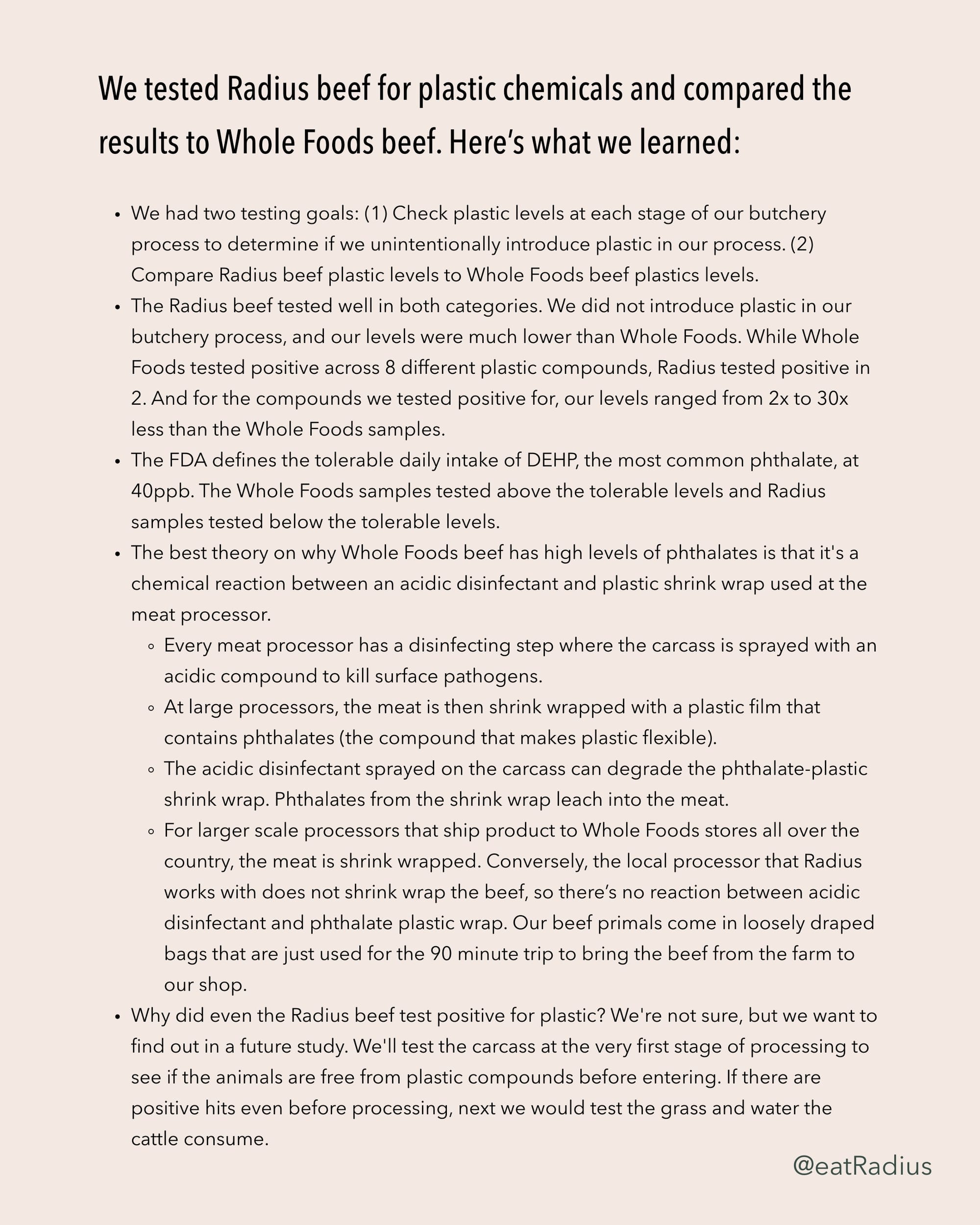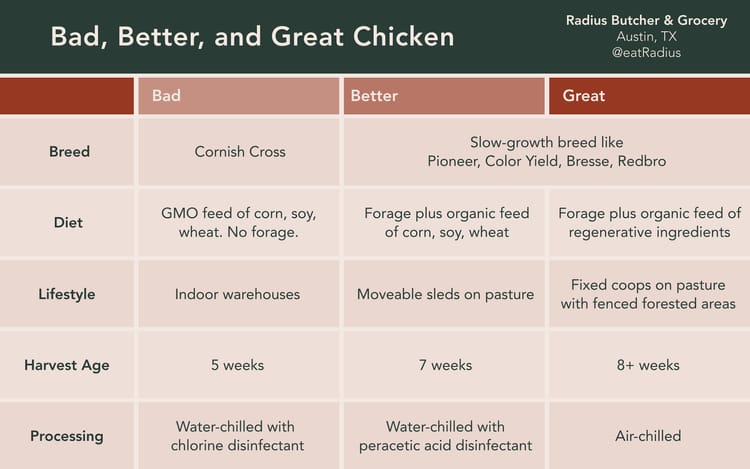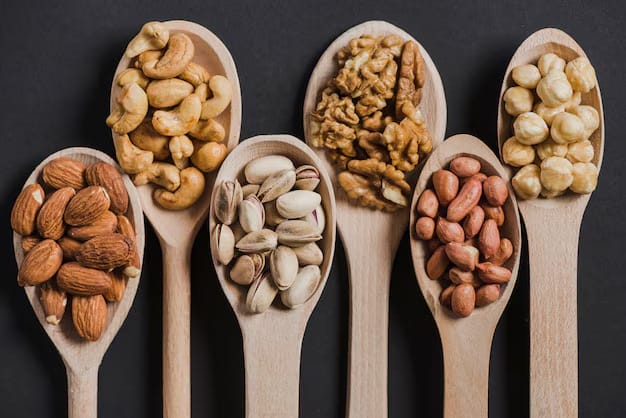We tested Radius beef for plastic chemicals
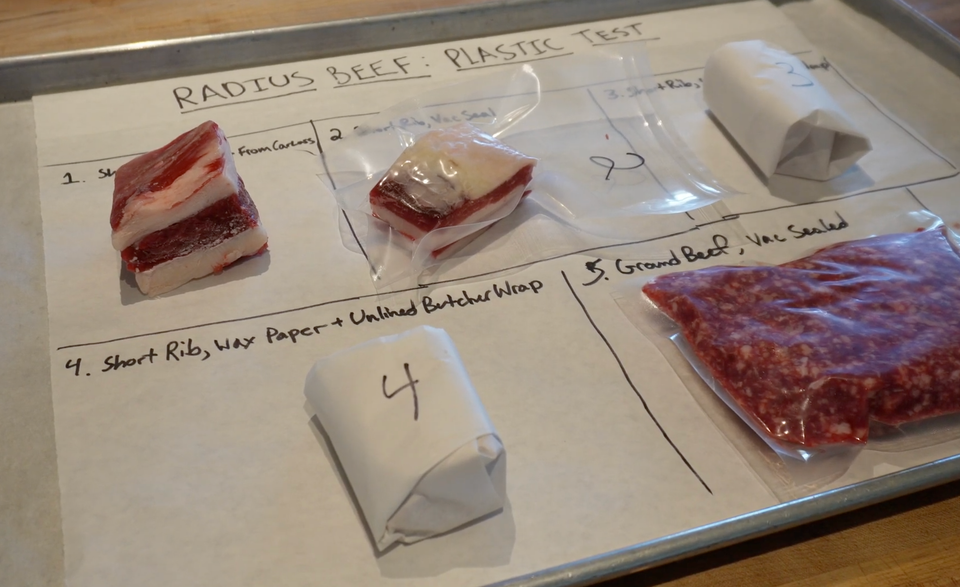
Inspired and terrified by the results of PlasticList’s food testing, we decided to test Radius beef for plastic chemicals. The PlasticList study tested ~300 food items for 18 types of plastic chemicals and found plastic in 86% of them. One of the most startling items was Whole Foods ribeyes which came back with high levels of BPS and seven different phthalates. We don’t want that in our Radius beef, so we tested it with the help of Light Labs. We had two testing goals:
- Check plastic levels at each stage of our butchery process to determine if we unintentionally introduce plastic in our process.
- Compare Radius beef plastic levels to Whole Foods beef plastics levels.
The Radius beef tested well in both categories. We did not introduce plastic in our butchery process, and our levels were much lower than Whole Foods. While Whole Foods tested positive across 8 different plastic compounds, Radius tested positive in 2. And for the compounds we tested positive for, our levels ranged from 2x to 30x less than the Whole Foods samples.
Our goal at Radius is to offer food to our community with the maximum amount of nutrients and the minimum amount of toxins. This is the first of many tests we’ll do to build the cleanest possible food system. Read on to learn more about the health implications of endocrine-disrupting chemicals, our test results, and our theory on why Whole Foods beef has such high levels of plastic chemicals in its beef.
Health Implications of Bisphenols and Phthalates
Some quick context about plastic chemicals before we dive into analysis. We tested for bisphenols and phthalates, which are categories of chemicals used to make plastic. Phthalates soften plastics, and bisphenols harden plastics. Bisphenols form hard, clear, heat-resistant plastics and are used in items like water bottles, food can linings, and medical devices. Phthalates make plastics more bendable and are used in items like food wrap and medical tubing.
Bisphenols and phthalates are endocrine disruptors, meaning they can interfere with the body’s hormone systems even at very low levels. These disruptions have been linked to a wide range of health concerns, including reproductive harm, developmental disorders, metabolic changes, and increased risk of hormone-related cancers. Children and pregnant women are especially vulnerable, as exposure during critical windows of development can have lasting effects. 1, 2
These health concerns make testing even more important when it comes to understanding chemical exposure in our food system.
The Data
Our first testing goal was to check plastic levels at each stage of our butchery process to determine if we unintentionally introduce plastic into Radius beef during butchery. We sent in 5 different samples, one for each stage of our butchery and wrapping process. Each sample was sent in a separate glass jar to prevent cross-contamination.
Each sample is tested for parts per billion — for each gram of beef sample, how many nanograms of plastic were found. We tested each sample twice for accuracy. Two compounds came back consistently positive from each sample and testing run — DEHP and DNP. For these compounds, the levels did not consistently increase at each stage. That is a good sign that we did not introduce plastic chemicals into the beef in the process of butchering and wrapping meat for customers.
Note there were some inconsistent positive hits in the tests as well — DNOP, DEHA, DIBP, and DPhP. It’s hard to know exactly how to interpret this. The best theory is a bit sad; the modern world just has plastic particles swirling in the air. While the lab of course did a blank control before testing our samples to set the air baseline, it’s possible some samples just had higher levels from air flow.
The second goal of our beef plastic testing was to compare Radius beef to Whole Foods beef from PlasticList, as well as the beef they tested from a Bay Area butcher shop. Radius beef and Bay Area butcher shop beef both came back with significantly lower plastic levels across the board than Whole Foods.
Key insights:
- Whole Foods beef tested positive for BPA and BPS; Radius and Bay Area butcher shop did not.
- All samples tested positive for DEHP, which is the most common phthalate. The Radius average was almost 10x less than the Whole Foods average. The Bay Area butcher was even lower than Radius; however, we ran 10 tests on the Radius beef (5 stages x 2 rounds), while the Bay Area butcher was only one test. We also took the most conservative average by throwing out the results that came back with 0 levels. My guess is if the Bay Area butcher shop had more rounds, the DEHP average would go up.
- Radius beef tested positive for DNP, while PlasticList didn’t split out that analyte specifically. It was likely rolled up into DEHP_equivalents. Comparing Radius’s 63ppb to the Whole Foods DEHP_equivalents levels, we’re again lower.
- The Whole Foods and Bay Area butcher samples tested very positive for DEHT, which is the most common “safe” replacement for DEHP. While DEHT likely is safer than DEHP, I’m personally a bit suspicious. We’ve seen this play out with BPA replacements like BPS and BPF that are maybe less toxic than BPA, but still have negative health implications and for now are just less tested.
- Whole Foods had other consistent positive hits — DBP, DEP, and DEHA — that were not found in the Radius samples.
Why is there plastic in beef?
Why does Whole Foods beef have such high levels of phthalates? And why did even the Radius beef and Bay Area butcher shop beef test positive for plastic?
The best theory on why Whole Foods beef has high levels of phthalates is that it's a chemical reaction between an acidic disinfectant and plastic shrink wrap used at the meat processor.
- Every meat processor has a disinfecting step where the carcass is sprayed with an acidic compound to kill surface pathogens.
- At large processors, the meat is then shrink wrapped with a plastic film that contains phthalates (the compound that makes plastic flexible).
- The acidic disinfectant sprayed on the carcass can degrade the phthalate-plastic shrink wrap. Phthalates from the shrink wrap leach into the meat.
For larger scale processors that ship product to Whole Foods stores all over the country, the meat is shrink wrapped. Conversely, the local processor that Radius works with does not shrink wrap the beef, so there’s no reaction between acidic disinfectant and phthalate plastic wrap. Our beef primals come in loosely draped bags that are just used for the 90 minute trip to bring the beef from the farm to our shop.
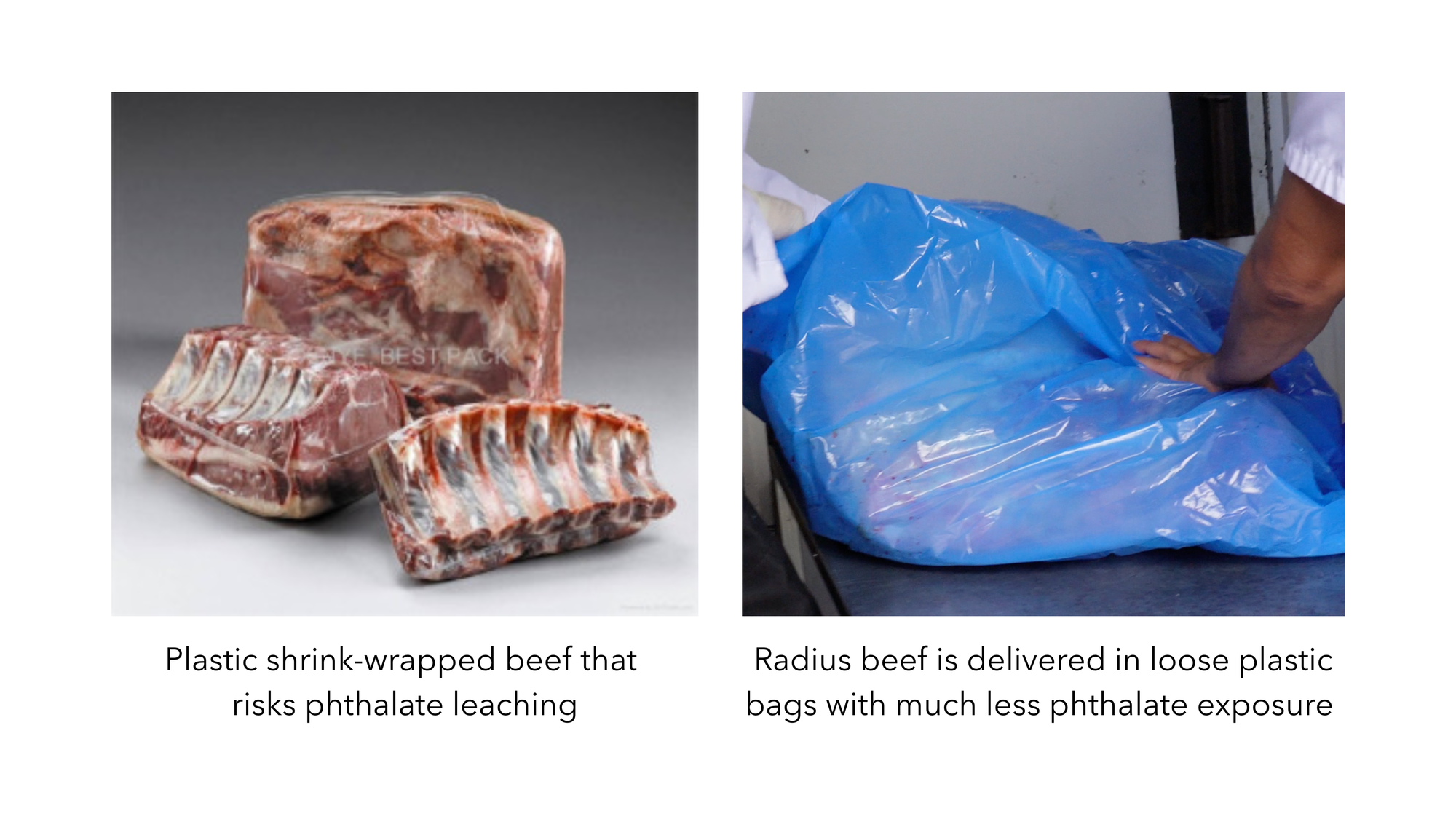
If Radius beef is never shrink wrapped, then why do even our samples test positive for low levels of phthalates? We're not sure, but we want to find out in a future study. We'll test the carcass at the very first stage of processing to see if the animals are free from plastic compounds before entering. If there are positive hits even before processing, next we would test the grass and water the cattle consume. This is all part of our effort to build the most nutrient dense, toxin free food system.
Are these levels a health concern?
DEHP is the most common phthalate and most studied for health implications. The Radius samples averaged 17 parts per billion, the Bay Area butcher’s one sample was 3ppb and Whole Foods ranged from 14.5ppb to 310ppb. To put this in human scale context, 17ppb means that in 1lb of beef, there would be 0.00000771 grams, approximately 1.6 millionths of a teaspoon.
Although these are tiny amounts to the human eye, they are near the threshold of safe levels as defined by the FDA. The FDA defines the tolerable daily intake of DEHP at 40ppb, which means the Whole Foods samples are above the tolerable levels and Radius and Bay Area butcher are below the tolerable levels. An additional concern is our bodies struggle to detox these chemicals, so they can build up over time. And if you have a smaller body (aka a kid), the levels will be more concentrated.
While there is still a lot of research needed to understand the health implications of phthalate and bisphenols, it is safe to assume that consuming food with lower levels is a good idea.
Summary and key points
